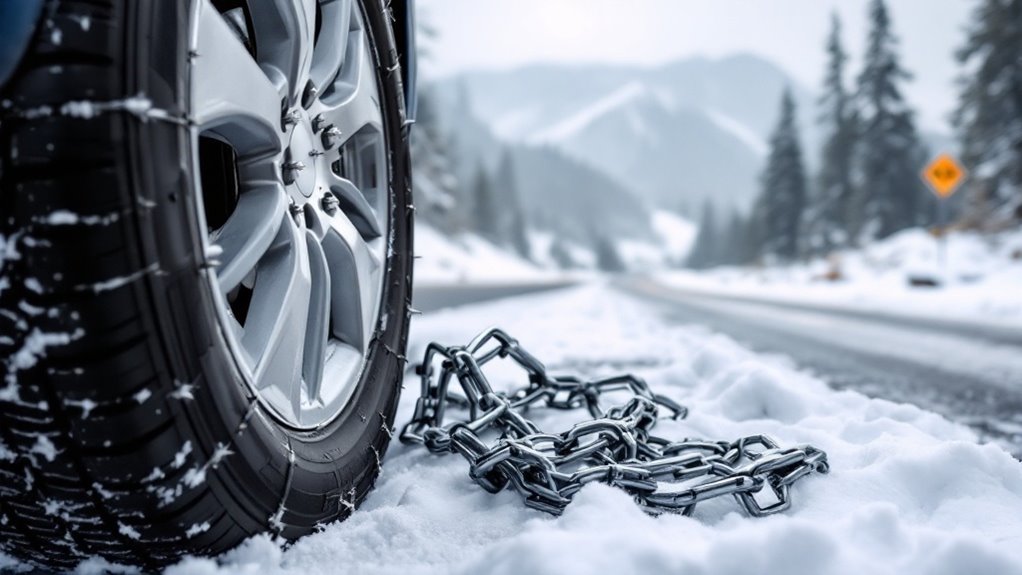Are Studded Tires Allowed In California
This post contains affiliate links. As an Amazon Associate, we earn from qualifying purchases.
Stud
Essential Facts in 30 Seconds
- Studded tires are permitted in California between November 1 and April 30.
- They can only be used on icy road conditions.
- Tires must meet specific material and coverage standards.
- Compliance is monitored by California Highway Patrol and Caltrans through inspections.
- Non-compliance may lead to fines and penalties.
Legal Guidelines for Studded Tires in California
Studded tires help tackle tough winter roads in California. Rules for using them are strict. California Vehicle Code Section 27454 sets clear guidelines. Stick to these to stay legal. Tires must use tungsten carbide studs or similar hard stuff. Studs can only cover 3 percent of road contact. That’s a small limit!
Check these key rules for tires:
- Studs made of tungsten carbide or equal.
- Only 3% metal touches the road.
- Studs stay inside tread if worn out.
Got retractable studs on your tires? Keep them pulled back outside allowed times. Breaking rules means fines. Studded tires are permitted from November 1 to April 30 seasonal usage period.
Check tires often for safety. Stay legal on California roads. Drive smart and avoid trouble!
Seasonal Restrictions and Enforcement

Winter driving in California gets tough sometimes. Strict rules apply to studded tires. Stick to these laws for safety. You can use studded tires from November 1 to April 30. Drive anywhere in the state during this time. Use them only if icy roads demand it. Studded tires enhance traction during winter conditions, making them a safer option when necessary.
Outside these dates, penalties hit hard. California Highway Patrol checks tires often. Caltrans also runs routine inspections. Breaking rules means possible fines. Remember, studded tires can cause significant road damage if not used properly.
Take care of your tires in winter. Check studs to keep them tight. Loose studs damage roads and risk safety. Watch for signs about chain control areas. Studded tires don’t replace chains.
Quick facts for you:
- Allowed time: November 1 to April 30
- Rule checks: Patrols and inspections
- Rule break: Fines may apply
Stay updated on road conditions. Mountain areas need extra caution. Drive safe and avoid trouble.
Studded Tires Versus Other Traction Devices

Driving in California winters can be tricky. Know the difference between studded tires and other options. This helps you pick the best for safety.
Studded tires grip well on ice near 32°F. But, they lose their edge in super cold or snowy weather. Advanced studless tires like Blizzak often match them. Are studded tires worth it? Maybe not for most drivers. Snow tires are specifically designed for optimal performance in cold weather conditions.
Try other tools like tire chains for great grip. Chains work awesome on snow and ice. But, putting them on is a big hassle. Snow socks are another choice for light snow. They give okay traction but wear out fast. Remember, tire chains are subject to state-specific regulations that vary by location and may restrict usage.
Studless winter tires use special rubber and tread. They grip well and stay quiet on roads. Check this simple list:
- Studded Tires: Top on ice at 32°F, very noisy.
- Chains: Super traction, tough to install.
- Studless Tires: Work everywhere, quiet, really good.
Safety Benefits and Road Impact

Studded tires bring big safety perks in California’s tough winter weather. They grip ice and packed snow like nothing else. Metal studs dig deep for amazing hold. This beats regular rubber tires by a lot.
Studies from Sweden show they cut accident risks by 20-50%. Near freezing, ice gets super slippery with a thin water layer. Studded tires help break that ice up. They make roads safer for everyone driving.
Still, they cause real damage to roads. Studs create ruts on highways fast. Ruts hold water and raise hydroplaning dangers. They also fade road markings, hurting visibility. Plus, they kick up dust, harming the air. Additionally, snow tires are often recommended for regions experiencing heavy winter weather.
Check these key points:
- Safety: Awesome grip on icy roads.
- Damage: More road wear, bigger repair bills.
Think hard about these pros and cons for winter driving.
Comparison to Regulations in Neighboring States

Let’s explore how California’s studded tire rules compare with nearby states. Rules differ a lot based on weather and road care needs.
California allows studded tires from November 1 to April 30. Oregon matches this exact time frame for usage. Nevada starts earlier on October 1 due to tough winters.
Check out Washington—they stop on March 31. Why? To protect roads from damage.
Take a look at this simple list:
- California: November 1 to April 30, no chains allowed.
- Oregon: November 1 to April 30, chains not mentioned.
- Nevada: October 1 to April 30, supports extra traction.
- Washington: November 1 to March 31, saves road surfaces.
Knowing these rules keeps you safe while driving across states. Stay ready for winter trips!
Frequently Asked Questions
How Do I Install Studded Tires Properly?
Got studded tires to install? Let’s do it right! Use your tools for perfect alignment. Place each stud with care. Push hard and twist them in slowly. This ensures a tight fit. Did you know? Proper studs boost grip by 30% on ice. Keep it simple and safe! Check each tire twice. A good setup means better control. Ready to roll?
Where Can I Buy Studded Tires in California?
Ready to tackle California’s icy roads? Studded tires are your safety key! Check out local tire shops for great deals. Many stores stock them during winter months. Online shops also deliver right to your door. Act fast before snow hits hard! Over 60% of drivers trust studded tires for grip. Specialty retailers offer expert help too. Don’t wait for the frost to strike. Gear up now and stay safe!
Are There Specific Brands Recommended for Studded Tires?
Are you searching for the best studded tires? I’ve got some tips! Many brands make great options for tough winter roads. Think about top names like Nokian and Michelin. They often lead with awesome performance in snow and ice. Studies show Nokian tires grip icy roads super well. Michelin also gets high marks for safety. Check reviews to see real user feedback. Visit local shops for tires that fit your car. Make sure they handle harsh weather conditions. Ask about deals to save some cash. Stick with trusted brands for the best results!
What Are the Fines for Using Studded Tires Illegally?
Think of rules as a tricky maze for drivers. Breaking laws on studded tires brings trouble. Fines in California often top $100 for this mistake. Stay alert to avoid these costly penalties. Know the tire rules to drive safely. Breaking them? Expect a big hit to your wallet.
How Do I Store Studded Tires Off-Season?
Got studded tires to store off-season? Let’s make it super easy! First, clean them well with soap and water. Dry them totally to stop rust. Next, put them in airtight tire bags. Store them in a cool, dry spot. Avoid hot or wet places. This keeps tires safe for next winter. Studies show proper storage adds years to tire life. Follow these steps and save money!
Conclusion
Are studded tires okay in California? Let’s break it down simply. Studded tires are mostly banned here. Only some strict rules allow them. Certain counties have seasonal permissions. These laws protect roads and keep everyone safe. Always check local rules before using them. Mountain areas like Tahoe might have different guidelines. Look at California Vehicle Code, Section 27454, for clear info. Stick to approved traction options for winter driving. Stay safe on the roads!
